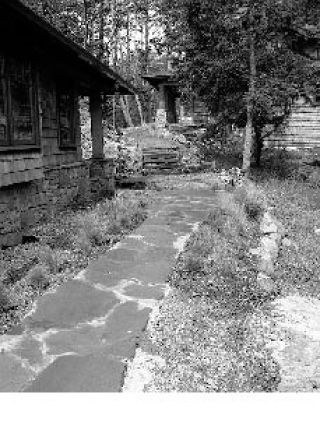Lopez Island stonemason David Anderson’s opinions are as strong as the materials with which he works. For example, he quickly and without hesitation dismisses an age-old question in aesthetic philosophy, that of when, exactly, craft becomes art.
“It happens when I’m doing the veneer, the finish. That’s the truly subjective part of the work, the moment when someone might walk by and ask ‘Why did you put that stone there?’ That’s the stage of my work where I’m relying almost wholly on my intuition, my artistic, creative decisions.”
For Anderson, the road from craftsman to artist started by cleaning chimneys. This led him to selling chimney repair jobs, for which he hired a mason, Clay Reimer, his first mentor in the long process of becoming a stonemason.
“My work in chimney restoration landed me a job restoring five historical homes in Seattle, a total of thirty different chimneys with underground brick foundations.”
This was Anderson’s first exposure to historical restoration, a passion which has driven him his entire life. While the art of his work is where the satisfaction lies, Anderson points out that many of the challenges of stone masonry are physical and logistical. “Much of what I do, at least at first, consists of getting heavy equipment and material to where it’s needed, then sorting the stone to create a staging area where my crew and I don’t have to be going back and forth to different piles for the right stone.”
“There is,” he states flatly, “a huge amount of logistical planning that goes on before the first stone is ever laid.”
Anderson, who has owned his own company, Anderson Masonry & Restoration (andersonmasonry.net) since 2003, does a variety of stone work. While much of this work is what he characterizes as vertical masonry work, which he describes as putting material up on walls, as well as restoring walls, he also builds fireplaces, chimneys, and stone walks. He designs and retrofits structures for seismic purposes, all the while utilizing all types of stones, as well as brick.
The artist in him delights in working with Ashlar stone patterns, what he considers to be the most beautiful of all stonework. When asked to explain to a lay person what an Ashlar stone pattern is, he says: “If you look at a castle, you see cut stones which have a very evolved look to them, like brick. Yet this stone was taken from a quarry and fashioned into the building material.”
He finds working with river stones particularly interesting, a task which can be challenging, though also immensely gratifying. “With river stones, I’m trying to capture the organic form that pebbles along a shore have naturally taken. Always keeping function in mind, it is this organic form that will elevate a simple wall to a piece of art, one that is fully integrated with its surroundings.”
Anderson is adamant about the importance of recognizing and using the columnar proportions first established by the Greeks in their architecture. “Going against these established parameters creates an energy that just isn’t right in our minds, that throws us off aesthetically.”
Like many artists and craftspeople, Anderson moved to Lopez to have the freedom to do more creative work. Among the local projects of which he’s most proud are an all natural stone fireplace at Johns Point and a stone wall at a private residence in Lopez Village. Of the latter, Anderson says the material was particularly challenging for the style of the wall and that the location was “absolutely spectacular.”
For the first time in this interview, Anderson is silent. When he speaks again, he says: “Stone masonry is a dying trade, for many reasons, not the least of which is we’re pricing ourselves out of existence. Both the labor and the materials are becoming cost prohibitive.”
True to his passion for historical restoration, Anderson is part of a small group who are keeping an ancient art alive.
Anderson may be contacted at dave@andersonmasonry.net or 468-2335; his portfolio may be viewed at his website andersonmasonry.net.




